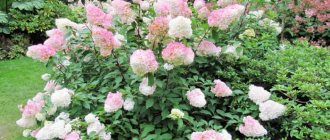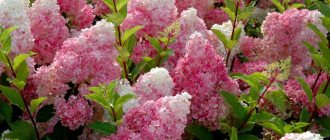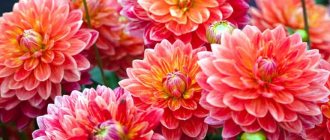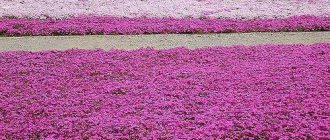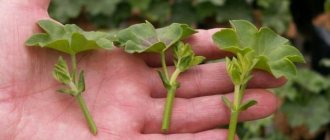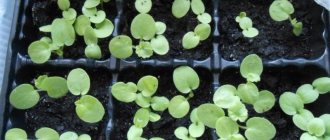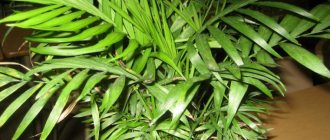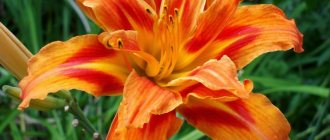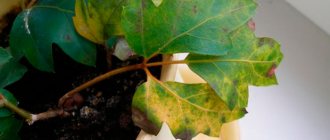Origin and appearance
Work on creating a paniculate garden crop capable of changing color has been carried out since the end of the 19th century. in France. Hydrangea Vinyl frieze is the result of breeding activities, which is why it was able to give it a number of characteristics.
Appearance of hydrangea Vanilla Fraze
For your information! The variety received its name because of its complex color, where white (vanilla) alternates with pink. The name translates as “vanilla strawberry”.
The stems of the plant are burgundy in color. The shoots are straight and rigid; under the weight of the vegetative part, the bush takes on a spherical shape. The leaves are oval, oblong. The inflorescences are cone-shaped, oblong, consisting of large flowers of a rich pink hue at the base, turning to vanilla at the top.
Description of flowering
The plant typically flowers in several stages. It starts in mid-June and lasts until October. By summer, buds appear and bloom like white flowers. Then gradually they turn to pink. In autumn, you can observe that the inflorescences turn burgundy-red.
Hydrangea Vanilla Fraze on a trunk
Some garden crops are grown in the shape of a tree to make them decorative. The part of the trunk up to the first lower tier of the stem is called the trunk. Planting and caring for the formation of a tree trunk require patience and time. It will take at least three years to obtain a standard culture.
The idea of forming a tree from a hydrangea is based on the fact that young shoots acquire rough bark and cannot send out young shoots. Only the top of the plant continues to develop further.
Hydrangea Vanilla Fraze on a standard
Hydrangea paniculata Vanilla Fries - photo of beautiful flowering
Hydrangea, as one of the most beautiful flowers, attracts gardeners and flower growers all over the world for a reason. Experts appreciate this ornamental plant's ease of care and varied color palette.
The Vanilla Fraze or Rennie variety is rightfully considered the best representative of its species, as it combines all the best qualities of hydrangea. Therefore, do not be afraid to start your gardening journey with this plant. The main thing is to adhere to all the features and rules that we described above. And then Hydrangea Vanilla Fraze will delight you, your family and friends with unprecedented beauty.
When to fertilize
Lack of regular feeding of the plant will lead to deterioration in appearance. Hydrangea paniculata on a trunk will grow slowly and produce fewer inflorescences. You need to start fertilizing the tree from the beginning of June. In this case, it is permissible to use different types of feeding - root and leaf feeding. In the latter case, drops of funds can spoil the attractiveness of the flowers, so it is better not to use these types of fertilizers during the period of vegetative activity.
Good growth and flowering rates can be achieved by using the following types of fertilizing:
- mullein infusion;
- urea.
The last fertilization procedure should be carried out no later than the end of August. This will prevent another period of growth and help the plant to survive the winter well.
Despite the attractive appearance and popularity of standard hydrangeas, not every gardener knows how to grow such a tree. Meanwhile, even a beginner can cope with this task. It is enough just to follow the recommendations of specialists and regularly care for the plant.
Hydrangea on a trunk, cultivation, care
Hydrangea is highly decorative. Thanks to this, it is popular among flower growers .
Many of them use a tree-like variety of shrub - hydrangea on a trunk. This method of forming a bush has a beautiful and well-groomed crown, dotted with huge inflorescences. It may seem too difficult to do this, but in fact, standard hydrangea is relatively easy to make with your own hands. In its ordinary form, hydrangea is a shrub up to 2 m high with one or two dozen straight branches, but slightly drooping at the ends. The standard variety has a central trunk, 30 to 150 cm long, branching from the top in the shape of a tree.
The root system of hydrangea allows you to grow tree-like varieties not only in open ground, but also in a separate container . Thanks to this “raising” of the bush above the ground level, the dimensions of the plant are reduced, it acquires a more compact and aesthetic appearance. Standard hydrangea bushes are widely used in landscape design.
The main difference in the appearance of standard and bush hydrangeas is the shape of the crown.
Features of care
It is very important where you purchased the hydrangea, is it really Vanilla Fries? This is difficult to determine when purchasing, so you need to choose a reliable seller from a nearby nursery or borrow from friends or neighbors in the garden. I bought it from a nursery, where I have been getting seedlings for many years and can always talk to the owner and clarify any questions that have arisen. The small seedling I purchased tried to bloom closer to September, but there is no need to give in to temptation - we will break off the flower cluster for more complete ripening, and therefore a safe winter. The literature describes the high frost resistance of the Vanilla Fraze shrub - up to minus 30 degrees
For the root system it may be so. But the branches are unlikely to overwinter at this temperature. In any case, we need to provide shelter for the paniculata hydrangea for the winter if we are guaranteed to preserve the branches. When planting in the spring, mulch the tree trunk to better retain moisture in the soil, because these plants love moisture. Mulch - peat, pine litter, weeded weeds. In the fall, at the first stable frost, hill up the tree trunk circle with the same materials to a depth of 10 cm. When planting, I cover the soil around the Vanilla Frize hydrangea with black spunbond, then cover it with loose mulch. This will protect the bush from freezing even in snowless November. I cover the branches with thick spunbond, tied with a rope, first remove the remaining leaves and cut off the dry inflorescences.
Tying is also necessary to avoid the bushes breaking due to the weight of the snow. Even if the branches freeze, Vanilla will renew itself from the lower buds or replacement buds at the root system. We cut out the dried branches in the spring.
Protecting plants from pests and diseases
Hydrangea Vanilla Fraze is quite resistant to diseases and pests. One of the few dangers is fungal diseases. If the summer is rainy and cool, the shrub may be affected by rot and powdery mildew. To protect hydrangea, you should promptly treat it with solutions prepared on the basis of fungicides.
Gardeners recommend paying attention to such preparations as Topaz, Fundazol, Fitosporin. Hydrangea can also get sick if it lacks nutrients.
In such a situation, chlorosis may begin. Identifying the disease is quite simple: it is characterized by symptoms such as yellowing of leaves, their curling and falling. Fertilizers that contain iron will help fight chlorosis.
Vanilla Fraze can attract various pests that feed on the sap of the bush. So if your hydrangea begins to dry out, its leaves fall off, and its growth slows down, check to see if the plant is infected with spider mites or aphids. It is possible that the hydrangea was attacked by snails. What to do if you find pests? First of all, you should use insecticides. “Akarin” and “Tanrek” are perfect. As a preventative measure, experts recommend using folk remedies - infusions prepared with garlic or onion peels.
Pests and diseases
Hydrangea Vanilla Fries has good immunity, so it rarely suffers from diseases. Nevertheless, the bush should be periodically inspected and, if necessary, immediately treated with medications or home remedies. Sometimes Frize is susceptible to the following diseases and pests:
- Chlorosis - the foliage turns pale and dies, while the veins remain green. It is necessary to carry out foliar treatment with a solution of iron chelate or sulfate (5 g per 10 liters of water for 1–2 bushes).
- Spider mites, aphids - can be treated with a soap solution or use any insecticide or acaricide (Biotlin, Akatara, Force, Enzhio, Vermitek and others).
- Rust, brown spot: spots of different shades appear on the Frize hydrangea, the plant lags behind in development. In this case, fungicides are used (Maxim, Tattu, Profit, Topaz, Skor, Bordeaux mixture and others).
Read more Why and what to do if the tips of hydrangea leaves turn black and dry
Treatment is carried out only in the late evening, when the sun is already low. It is advisable to spray the bushes of paniculata hydrangea Vanilla Fries in dry and windless weather.
Advice! For preventive purposes, fungicide treatment can be carried out as early as April or May.
Botanical description
The paniculate standard hydrangea Vanille Fraise was bred in a French nursery. Painstaking work on this variety of perennial began back in 1989. Breeders set themselves the task of developing a variety that would be able to change the color of the petals from white to pink in a short period of time. Thanks to the experience of breeders and their painstaking work, the world saw a gorgeous plant with large inflorescences resembling an ice cream cone and a huge number of flowers. The perennial was given a name in honor of the complex color of the resulting inflorescences (a combination of white and dark pink).
Reference! Fraise means strawberry in French.
According to the information specified in the characteristics, the paniculate hydrangea shrub reaches a height of 180-200 cm. Flexible shoots are painted dark burgundy. The green foliage densely dotting the branches resembles an oval shape.
The flowering period, which began in early summer, continues until October. The inflorescences, the length of which is in the range of 30-35 cm, are naturally endowed with a pyramid shape. The white petals gradually turn pink, and in early autumn they take on a burgundy-red hue. Flowering pleases the gardener in the year of planting. The perennial is unpretentious and can tolerate frosts down to -34 °C.
Note! Hydrangea Vanilla Fraze is used by landscape designers when designing park areas, garden plots, and local areas. After the inflorescences have been cut, they remain fresh for a long time
Proper feeding
You can start feeding your plant as early as May, preferably at the end. You can use any mineral and organic fertilizers . If there are none, then you can resort to various complex fertilizers (for example, liquid complex fertilizers or fertilizer mixtures).
The next fertilizer intake is carried out after 2-3 weeks. This is done in order to support the growth of the plant and saturate it with the necessary nutrients.
Do not forget that in the spring, after hibernation, a weakened plant also needs a new supply of vital substances. Fertilizers containing a large amount of nitrogen are suitable here .
In summer, you can feed the bush with a solution of fermented grass or use special fertilizers for hydrangea. You need to continue feeding the plant both at the end of summer and at the beginning of autumn. At this time, superphosphate is perfect for replenishing reserves.
Note! If you do not have the opportunity to use specialized fertilizers for hydrangeas in the summer, then you can replace them with compounds for azaleas or rhododendrons.
Brief description of the variety
Panicle hydrangea variety Vanilla Fries can reach one and a half meters in height. The crown cross-section is approximately 2 m.
The decorative features of the paniculate Vanilla Fraze variety are due to young erect shoots with a red color. During the flowering period, they begin to bend as the flowers exert pressure. This is what gives the shrub its spherical shape.
The foliage of Hydrangea paniculata Vanilla Frize is dense, oblong in shape, and dark green in color. The leaves have pubescence, which is often associated with a velvety cover. Mature plants of the Vanilla Fraze variety have a small root system with a large number of branches.
In terms of the shape and shade of the inflorescence of the paniculate shrub, Vanilla Fries can be compared to a strawberry-vanilla cone. Hydrangea forms wide-pyramidal inflorescences, initially painted white, but after some time in a soft pink color. By autumn, the flowers become darker.
Hydrangea paniculata Vanilla Fraze is planted in regions with both warm and cold climates; the main thing is to provide the plant with the necessary care.
This variety of paniculate hydrangea is highly resistant to diseases and pests. Vanilla Fries bushes can be attacked by insect pests or some diseases. Most often, paniculate varieties are subject to the following ailments:
- chlorosis;
- powdery mildew;
- spider mite;
- aphid.
Hydrangea paniculata Vanilla Fraze is a fairly large flowering shrub, which, with proper care, quickly reaches a height of 1.5 m. With regular pruning, its height does not exceed 2 m, and the bush is compact. The shoots of this variety are quite thin; when young they have a bright cherry color. Under the weight of the inflorescences, the plant's branches may droop.
During the growing season, the bush grows a large number of oblong dark green leaves. The leaf blades of this variety are simple, pubescent, and have a very attractive velvety appearance.
At the beginning of flowering, the hydrangea inflorescence is white, and over time it becomes two-colored with a white tip. At the end of flowering, all inflorescences turn completely red. Thus, on one hydrangea bush there can be inflorescences of bright and very varied colors. Such a rich color palette attracts many gardeners.
The plant is frost-resistant enough to be grown in temperate climates and in some areas of Siberia and the Urals without shelter. It winters well at temperatures down to -30°C. It can also withstand temperatures down to -40°C. If during the winter some shoots of the plant freeze slightly, then with the onset of spring they quickly recover.
This variety is very durable. Hydrangea paniculata "Vanilla Fries" lives up to 40 years, and sometimes there are older, but abundantly flowering specimens.
Reproduction methods
Vanilla Fraise, like other paniculate hydrangeas, reproduces vegetatively:
- Dividing the bush.
- By layering.
- By cuttings.
You can divide adult bushes with developed roots. This can be done in spring or autumn. The resulting divisions should have several healthy shoots.
Paniculate hydrangeas are propagated by layering in spring or early summer. Choose a healthy lower shoot, pin it to the ground and dig in a little. After 2 months, when the cuttings take root, they are separated or transplanted to a permanent place, fed with complex fertilizer and watered abundantly. They are well covered for the winter.
Propagation of hydrangea paniculata Vanilla Fraze by cuttings
It is advisable to cut the paniculate hydrangea Vanilla Fries in early spring, before the active movement of juices begins. The sequence of actions is as follows:
- Lignified shoots from last year are trimmed.
- Several cuttings with two internodes (3 pairs of buds) are cut.
- Prepare a mixture of peat and coarse sand (2:1).
- Planted in a greenhouse, moistened, covered with a lid and grown in a room or other heated room.
- After 1.5-2 months, the cuttings of paniculata hydrangea Vanilla Frize are transplanted to a permanent place.
Where can I plant it?
As mentioned above, all paniculate hydrangeas, in particular the Vanille Fraise variety, are quite unpretentious plants and can grow in both sun and partial shade. However, when planting this perennial in a sunny area, you should remember that its growth rate will be noticeably lower than in the shade. Such a bush will be quite low, and the inflorescences will be small. Under no circumstances should there be limestone soil in the area where Vanilla Frazee hydrangea will be planted.
- slightly acidic or neutral;
- fertile and loose;
- enriched with organic fertilizers;
- moderately, but constantly moisturized.
If you decide to plant this beautiful flowering shrub in a shady corner of your property, you will have to constantly ensure that the soil at its roots is loosened all the time. If you have neither the strength nor the desire to loosen all the time, then you can make your life easier by introducing a little bit of any mulch into the ground under the hydrangea during the first treatment.
How Vanilla Fraze blooms
Among all its paniculata brethren, it is Vanilla Fraze that attracts attention with its bright appearance. This plant is very noble and therefore, if you give it proper care, it will definitely give you beautiful flowers and become an excellent decoration.
As mentioned above, hydrangea can easily reach large heights and widths. One bud of this variety easily reaches a width of about 30 centimeters, and a width of 40 centimeters. And in appearance, such a bud will look like an ice cream cone.
This variety blooms for a very short time, only a few months. The first buds begin to bloom in mid-summer, and in September they begin to prepare for rest. The flowering features of the Vanilla Fries variety include, of course, the stunning range of colors that this plant is rich in. At first, the flowers have a soft cream color, and then gradually the petals turn pink.
Things only get more interesting from there. As the hydrangea continues to bloom, it first turns bright red in the lower part. And then it gradually lightens and acquires a calm pink color. But the upper part confidently adheres to white shades.
Note! Such characteristics of hydrangea flowering are found only in the Rennie variety.
By following all the rules for caring for and growing hydrangea in the garden, you are given an amazing chance to see with your own eyes all the beauty of this plant. And the more often and better you prune, the more buds your bush will give you.
Hydrangea Vanilla Fraze in landscape design
The expressive and spectacular appearance of the ornamental shrub has attracted the attention of landscape designers. Panicle hydrangea Vanilla Fries is actively used for landscaping garden plots and beautifying city parks. The plant can be used to decorate:
- hedges;
- garden paths;
- recreation areas;
- artificial and natural reservoirs;
- mixborders of various types;
- decorative installations.
Vanilla Fraze looks interesting both in compositional and solitary plantings. When planted in groups, it can be combined with coniferous, deciduous and other flowering crops.
Hydrangea care
For the normal development of the bush and its long flowering, it is necessary to ensure:
- Regular watering;
- Mulching the soil;
- Feeding
- Annual pruning;
- Preparing for winter.
It is necessary to ensure that the soil under the Frize Melba hydrangea bush is moist. To do this, the plant is watered with non-cold, settled water. For watering, 10 liters of water per bush is enough. In spring and autumn, it is recommended to water every week in dry weather, and in hot summers - 2 times a week.
Mulch the tree trunk circle after the first watering. The ground around the trunk is covered with a layer of sawdust, crushed bark or peat. The mulch layer should be at least 7 cm. It protects the soil well from drying out and the root system from overheating in the summer heat. Over time, the mulch rots and becomes an excellent fertilizer for the Frize Melba hydrangea.
For proper development, the plant needs feeding. It is carried out during the growing season and flowering 2 times a month. It is advisable to alternate organic and mineral fertilizing. This variety requires feeding with lime, which is carried out monthly.
For regular and long-term flowering, trim the hydrangea “Fries Melba”. It is carried out 2 times a year - in spring and autumn.
When grown in regions where the temperature in winter does not fall below 30°C, preparing the shrub for winter consists only of autumn pruning. In areas with harsh climates, it is recommended to cover this plant for the winter. Usually a frame is built around the bush, which is covered with film. Then, when snow falls, the film is covered with snow on top. You can also use spruce branches or dry leaves.
You can learn about hydrangea diseases here.
Care
The main task of caring for paniculate hydrangea is to achieve high-quality flowering. This is done by watering and fertilizing. But pruning is also important - it creates the shape of the bush. This variety can be affected by some diseases and pests, so appropriate preventive measures are necessary.
Watering and fertilizing
The moisture-loving crop needs to be watered every week. It is important not to allow the soil under the hydrangea to dry out. For one Vanilla bush you need to add about 10 liters of water. In dry summer weather, you will need to irrigate the plant more often - up to 3 times a week.
Important! Use settled warm water when irrigating the variety.
The application of organic and mineral fertilizers and their alternation has a beneficial effect on the development of the crop.
The method of feeding hydrangea is as follows:
- first apply the funds in the spring, when the buds swell (mullein and water - 1:15);
- then - as soon as the buds appear (ammonium nitrate, potassium salt and superphosphate - 30 g of each product, diluted in water);
- further - with active flowering (the previous point is repeated);
- The last feeding is carried out during preparation for wintering, that is, in the fall (potassium sulfate and superphosphate, 30 g each, which are mixed and diluted in water for irrigation).
With this feeding, Vanilla Fries will bloom and develop well.
Trimming
To give shape to hydrangea paniculata shrubs, pruning is carried out before sap flow begins. All damaged and dried shoots are removed. It is correct to shorten branches by a certain number of buds - about seven. It is recommended to leave about 10 stems.
It is also customary to perform Vanilla Fries rejuvenation. To do this, cut all shoots to a size of 15 cm each. In the summer, when the crop is actively blooming, it is worth removing dry and wilted inflorescences. In this case, new buds are better formed on the bush.
Loosening and weeding
To carry out watering correctly, you should loosen and hill up the soil around the bush, and it is also useful to mulch the soil. You need to make sure that the roots are not exposed. Weeding is important, but proper mulching will not only help maintain moisture, but also control weeds.
Proper wintering
In central Russia and to the south, Vanilla Fries does not need to be covered for the winter. But if there is little snow, it is necessary to protect the plant with mulch in the form of peat or humus. The layer height should be from 20 to 30 cm. And young hydrangea should be covered with burlap or other convenient material before wintering. Applying snow mass also insulates the crop.
Prevention of diseases and pests
Fungi, powdery mildew and rot are fairly common types of damage to this variety. The last two can overcome shrubs under conditions of high humidity and low air temperature. The use of fungicidal agents such as Fundazol or, for example, Topaz in late autumn is an excellent disease prevention.
Important! For those who love low-growing crops, it will be important to know: in 2022, a dwarf form of the described variety appeared - Hydrangea paniculata Little Frize.
To avoid chlorosis, in which the leaves turn yellow, curl and fall off, Vanilla Fries needs to be additionally fertilized with iron preparations. Chlorosis occurs due to lack of nutrients.
Pests of the crop are:
- snails;
- aphids;
- spider mites.
Spraying with insecticides (for example, “Akarin”) is carried out to combat insects, and a preventive measure is the use of traditional methods: irrigation with infusions of onion or garlic peels. Such watering can be carried out at any time during the growth and development of hydrangea.
Hydrangea Vanilla Fraze in landscape design
The Vanilla Frize shrub can be planted singly or in combination, which is necessary to form a hedge. The plant can be trimmed and modeled.
Hydrangea Vanilla Frazee, planting and caring for it in open ground includes several stages, will eventually bloom all summer. First you need to choose a suitable place for planting, then provide food and care to the bush.
The plant is demanding on soil quality and moisture level. Therefore, the hole where the shoot will be planted must be filled with nutritious soil. It should consist of a mixture of peat, humus and sand in a ratio of 2:2:1.
Important! The soil for planting hydrangeas should be slightly acidic or neutral. It depends on the region where the planting takes place
In the northern part of the country, you need to choose a southern location not in the sun. In the central part you can plant shrubs in partial shade
It depends on the region where the planting takes place. In the northern part of the country, you need to choose a southern location not in the sun. In the central part, shrubs can be planted in partial shade.
The shoot needs to be replanted in the spring, but is allowed in the fall before frost. The nursery takes young shoots without signs of disease, about 30 cm high. Planting Vanilla Fraze hydrangea in the spring includes the following sequence of actions:
- At a distance of 1-2 m, holes measuring 50 cm² are dug.
- After preparing the nutrient soil, add superphosphate and potassium fertilizer.
- 2 weeks before planting, fill each hole halfway with the resulting mixture.
- After the soil settles, a seedling is placed in it, soaked for 2 hours in a growth stimulator.
- Water with warm soft water.
To propagate the plant, several methods are used. The most common option is cuttings, although seedlings can also be grown at home. Another way is to divide the bush, when in the spring several shoots with a root system are separated from an adult hydrangea.
When choosing a place to plant hydrangea, you should take into account that it is not too demanding on lighting and can grow in partial shade. But if the sun does not illuminate the plant at all, its inflorescences will be small and pale.
In the southern regions - Rostov, Krasnodar and others, it is preferable to choose areas with partial shade, and where the climate is harsher, it is better to plant in a sunny area.
- Places for planting holes are marked, taking into account the size of future bushes (the crown of an adult bush in cross section reaches one and a half meters).
- Dig holes with a depth and diameter of at least half a meter.
- A ten-centimeter layer of drainage (expanded clay, broken brick, small stones with sand) is placed at the bottom of the hole.
- The soil for filling the holes is prepared from humus, peat, sand and turf soil; you can also use a ready-made soil mixture for hydrangeas or azaleas.
- The holes are watered and allowed to settle.
- The roots of the seedling are slightly shortened, the seedling is also cut off, leaving three or four buds, after which the bush will begin to produce new side shoots.
- Hydrangea seedlings are planted, straightening the roots. If the planting material was purchased in a pot, then it must be planted together with a lump of earth. The root collar should not be buried; it should be located at ground level.
- The seedling should then be watered generously and mulched with organic mulch.
If planting took place on a sunny, hot day, the seedlings must be shaded with non-woven covering material or other similar means.
Planting and care
The plant is light-loving, but also feels great in the shade. The plant must be planted on the sunny or shaded side in a planting hole with the addition of acidic peat. Vanilla fries loves fertile, light, moist soils with high acidity.
The plant should not be kept in soils with high lime content. This can cause illness and death.
In cold regions, planting is best done in the spring. The distance between plants should be at least 1-1.5 meters. After planting, the seedlings need to be watered abundantly and loosened a little. The general watering regime is plentiful, especially in dry weather. It is best to use collected rainwater. Fertilizing must be done with mineral fertilizers and manure liquid every two weeks from April to August. Good feeding will create conditions for rapid growth and abundant flowering.
You can learn more about the rules for planting and caring for paniculata hydrangea in open ground here.
Trimming Vanilla Fraze
Important details of hydrangea care include pruning. It is best to carry it out in early spring, right before the juices begin to flow.
At the end of pruning, it is worth leaving from 5 to 10 shoots. It is also worth cutting out weak and thin branches and dry inflorescences. Do not forget that the method of pruning shoots greatly influences the size of the plant in the summer season.
If you cut a branch so that, for example, two buds remain on it, then you will grow few buds, but the flowers will be large.
Note! If sap flow has already begun, then pruning should be postponed until the petals fully bloom.
Hydrangea paniculata Vanilla Fraze propagation
Dig up the soil in partial shade, and then mix it with sand, peat, and agroperlite. After this, add a little humus, and then fill it with sand on top. You can plant the cuttings obtained after pruning into the resulting mass. The holes under them can be additionally fertilized with a root former. Then you can place arcs over the planted cuttings and cover them with damp non-woven material, placing a film on top. If the sun falls on the garden bed during the day, it is best to shade mini greenhouses so that the plant does not “burn” from the high temperature. Periodically, the film needs to be lifted to check the condition of the soil. After the cuttings take root, they can be planted in pots or in the garden. This is a fairly simple way to plant hydrangeas.
Pruning and propagation
In the fall, Vanilla Fraze fades and needs care. As they fade, cut off the inflorescences. This process is usually carried out in late autumn in order to avoid branches breaking off. Every year in the spring the shoots are shortened by 2/3 of their length. This procedure stimulates the development of shoots. And at the same time, it is necessary to remove all weak shoots that thicken the crown.
Most often, paniculate hydrangea is propagated by cuttings. The procedure is carried out in the first ten days of June. If done at another time, they are unlikely to take root. A cutting with 5-6 nodes is required. You need to cut off the leaves of the two lower ones and dig the cutting into two nodes in loose soil. It is advisable to add sand to the soil. Leave only 2/3 of all the leaves on the cutting and cover it with a three-liter jar on top.
It is imperative to root the cutting in the shade and constantly ensure that the soil near it is always moist.
